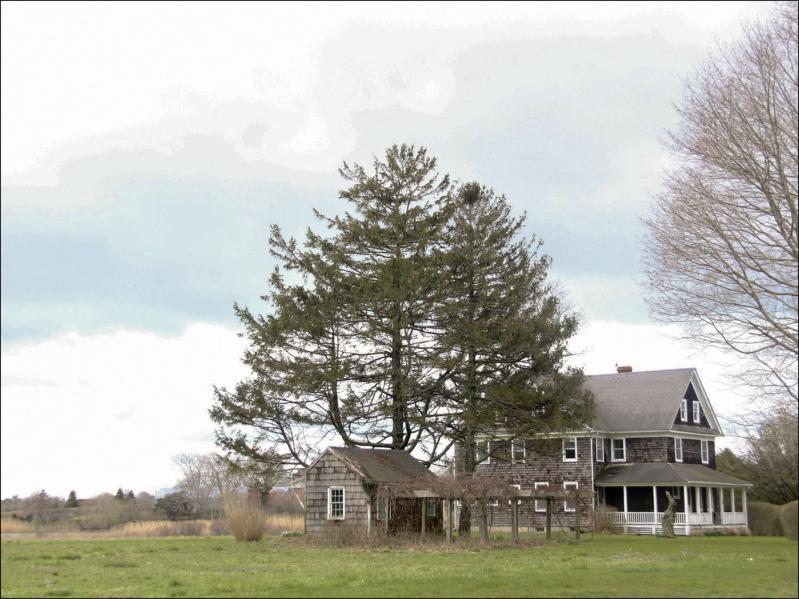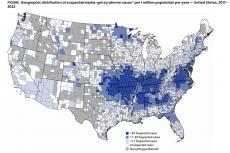A not-for-profit licensee in one or both of the historic buildings at the John Osborn homestead at 66 Main Street in Wainscott was only one aspect of a draft management plan contemplated by the East Hampton Town Board last week for the 30-acre parcel the town preserved last year.
The plan was divided into two sections: one that focused on the historic structures, and the other on the land and pond beyond.
“The primary goal is to encourage public enjoyment of this historic homestead, and through it, gain an environmental, economic, and sociological understanding of the evolution of Wainscott from the early-19th century to the present day,” read the draft.
A walking loop, agricultural operations, duck hunting, parking, water quality remediation and, perhaps most important, the view over the meadow and to Wainscott Pond from Main Street were all discussed in the document, though in purposely vague language.
“At the time of its writing, the town board does not have a specific use or user group in mind,” the draft plan says. “It is recommended that a clear understanding of community need within this area of Wainscott should be sought in order to help inform the town board’s decision with the end use of this property.”
The board hoped to find occupants for the main Osborn House and for a two-story wood frame barn. In the absence of licensees, the town will be tasked with maintaining the structures.
“We’ve already hired an engineer who is creating a scope-of-work cost estimate and building plans to help arrest any deterioration of the house,” said Scott Wilson, the town’s director of land acquisition and management. He noted that the house has several leaks in its roof and some rotting windows.
Jaine Mehring, speaking as a board member of the Wainscott Heritage Project, pushed again for stronger historic designations on the property.
“It remains absolutely essential that a full local historic designation be established by this board over the entire parcel,” she said. In March, the board designated only the structures as historic. She hoped the historic designation would be treated “as a critical element in the management plan as it moves forward.”
Further, she said her group had submitted a letter to the town board offering input on the draft management plan.
Unfortunately, the board did not have time to review the letter before its meeting, so it had the effect of stifling the dialogue somewhat, with a few board members indicating they would like to read it before diving too deep.
It’s been about a year since the town board used $56 million of Community Preservation Funds to buy the homestead.
While it was the first time the town board was looking at the draft management plan, it had been discussed previously, during three meetings of the property management committee, to which Councilman Ian Calder-Piedmonte is the board’s liaison.
Ms. Mehring and the Wainscott Heritage Project were active participants in those meetings. A Freedom of Information Law request produced the letter they submitted to the board.
Importantly, they wrote that while active farming could be considered, “agricultural land preserved as meadow or fallow field is also an appropriate, and likely preferred, use.”
Still, if a portion of the land is ultimately farmed, the Wainscott group called for a “strong limit on farm structures,” with the view from Main Street being key, and said whatever farming occurs must be compatible with any water quality initiative undertaken by the town.
And while any potential licensees in the historic structures must be not-for-profits, it wasn’t clear if an agricultural licensee would check that box. The Wainscott Heritage Project letter called on the town board to answer that question in the future management plan.
If there was one concrete action taken by the board last week, it was to strike a prohibition on deer fencing from the draft management plan, despite its apparent focus on preserving the view.
“I worry about the precedent of getting very specific about how it may be used for agriculture if agriculture is chosen,” said Councilman Calder-Piedmonte.
He had support from Councilman David Lys, who said, “I think there can be deer fencing that is low. We see that at the airport. There’s different designs.”
Apart from its recommendations on farming, the Wainscott Heritage Project said that a paved multiuse path was “not an appropriate option for this particular site.” Given the wildlife present, members wondered if biking should even be allowed and recommended only leashed dogs, if they were permitted at all.
They also suggested the board approve a meadow maintenance schedule and plans for removing invasive plants.
Mr. Calder-Piedmonte indicated that a simple mowed path would be the first step to any future pedestrian access. The draft management plan called for a .5-to-.85-mile loop.
Because it’s a community preservation fund acquisition and the public would be invited to use it, parking is necessary. Both the draft management plan and the Wainscott Heritage Project sought to keep it at a minimum, prioritizing the use of existing parking areas.
The Wainscott group recommended setting a maximum parking amount and showing areas where parking would never be permitted.
Then there was the pond. The draft management plan contemplated eventual public access to its waters once properly remediated, and duck hunting.
“I just want to make sure it’s perfectly clear that water quality projects such as a permeable barrier can be put underground here,” said Councilwoman Cate Rogers. It appeared the plan was vague enough to allow them. Mr. Lys wanted to ensure the town board had final say and control over the pond, for example, allowing trustee access only with town board approval.
“This plan shouldn’t give carte blanche to any neighboring property owner or municipality to go across the town’s land without authorization,” he said.
For its part, the Wainscott Heritage Project suggested an entire section of the plan be dedicated to water quality remediation.
The draft management plan did not discuss special events and the Wainscott Heritage Project wants to see a section on types and number allowed, their size, and explicit prohibitions on commercial activities, illumination, and amplified music.
The plan will be back before the board in December. Once approved, a public hearing will be scheduled.
“In the meantime, we’re progressing with the stabilization of the structures,” said Mr. Calder-Piedmonte.




